BMP4002 Business Law: UK Legal Context for Business Organizations
VerifiedAdded on 2023/06/08
|10
|2861
|210
Report
AI Summary
This report provides an overview of the legal context for business organizations in the UK, covering key sources of law and their implications. It discusses the nature and management of companies, different types of business laws (employment, immigration, contract, antitrust, intellectual property, and taxation), vicarious liability, and business liability in negligence. The report also examines the roles, responsibilities, and liabilities of company directors, the procedure for terminating a partnership, and the meaning of the memorandum and articles of association. Different types of frameworks for partnerships, including sole traders, general partnerships, limited partnerships, and limited liability partnerships, are analyzed, along with relevant enactments. The document concludes with recommendations based on the findings. Desklib is a platform where students can find more solved assignments and study tools.
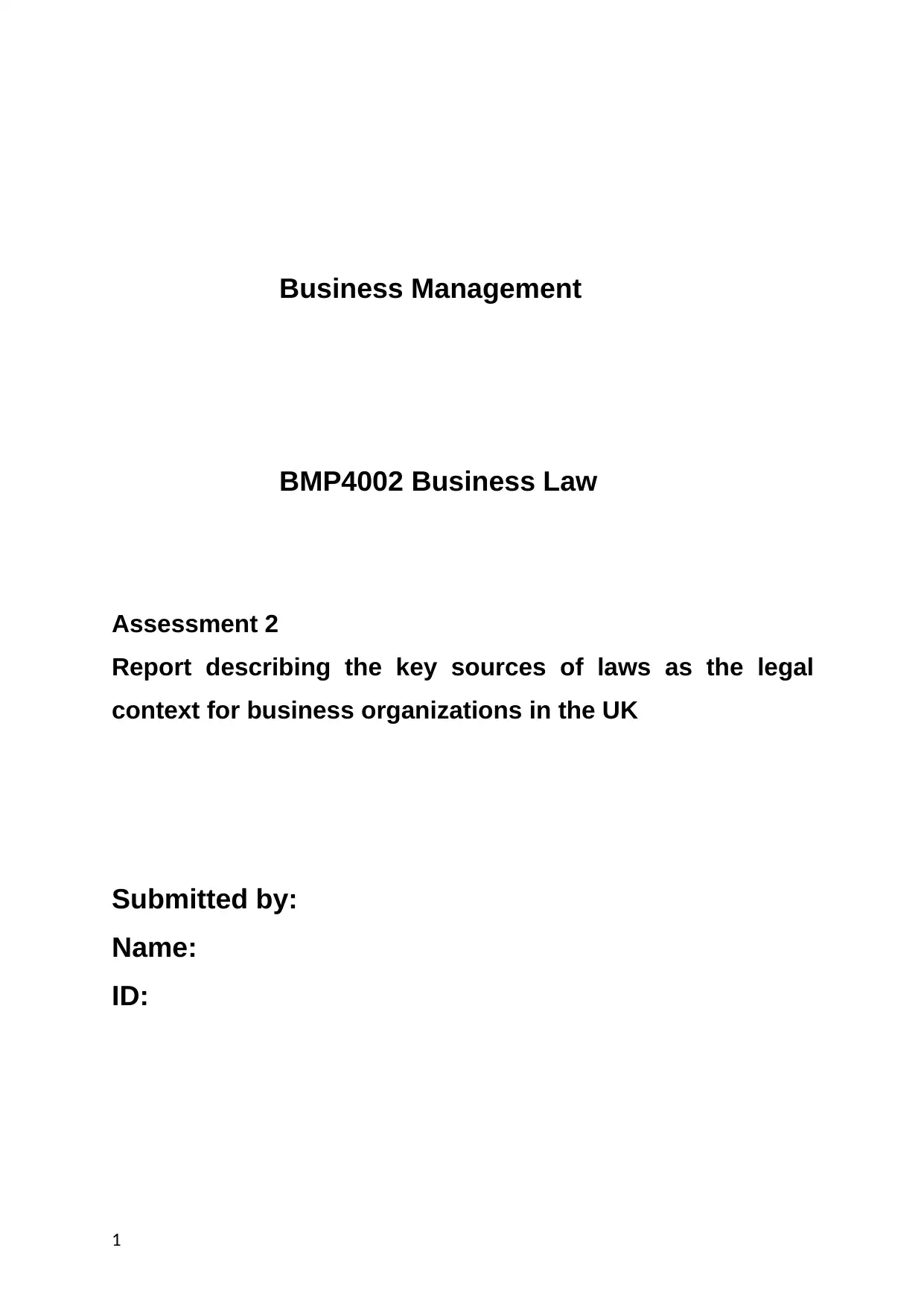
Business Management
BMP4002 Business Law
Assessment 2
Report describing the key sources of laws as the legal
context for business organizations in the UK
Submitted by:
Name:
ID:
1
BMP4002 Business Law
Assessment 2
Report describing the key sources of laws as the legal
context for business organizations in the UK
Submitted by:
Name:
ID:
1
Paraphrase This Document
Need a fresh take? Get an instant paraphrase of this document with our AI Paraphraser
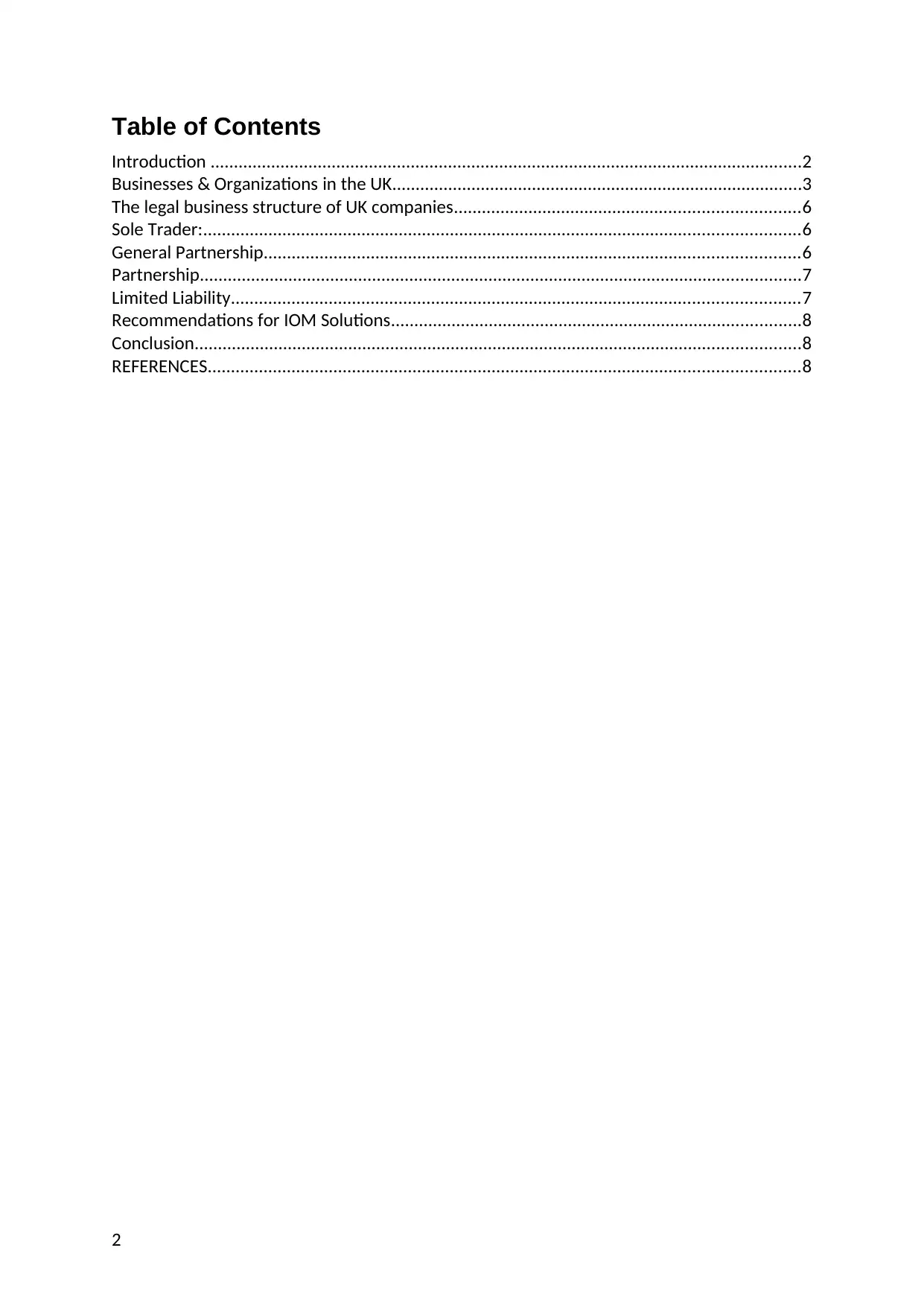
Table of Contents
Introduction ...............................................................................................................................2
Businesses & Organizations in the UK........................................................................................3
The legal business structure of UK companies..........................................................................6
Sole Trader:................................................................................................................................6
General Partnership...................................................................................................................6
Partnership.................................................................................................................................7
Limited Liability..........................................................................................................................7
Recommendations for IOM Solutions........................................................................................8
Conclusion..................................................................................................................................8
REFERENCES...............................................................................................................................8
2
Introduction ...............................................................................................................................2
Businesses & Organizations in the UK........................................................................................3
The legal business structure of UK companies..........................................................................6
Sole Trader:................................................................................................................................6
General Partnership...................................................................................................................6
Partnership.................................................................................................................................7
Limited Liability..........................................................................................................................7
Recommendations for IOM Solutions........................................................................................8
Conclusion..................................................................................................................................8
REFERENCES...............................................................................................................................8
2
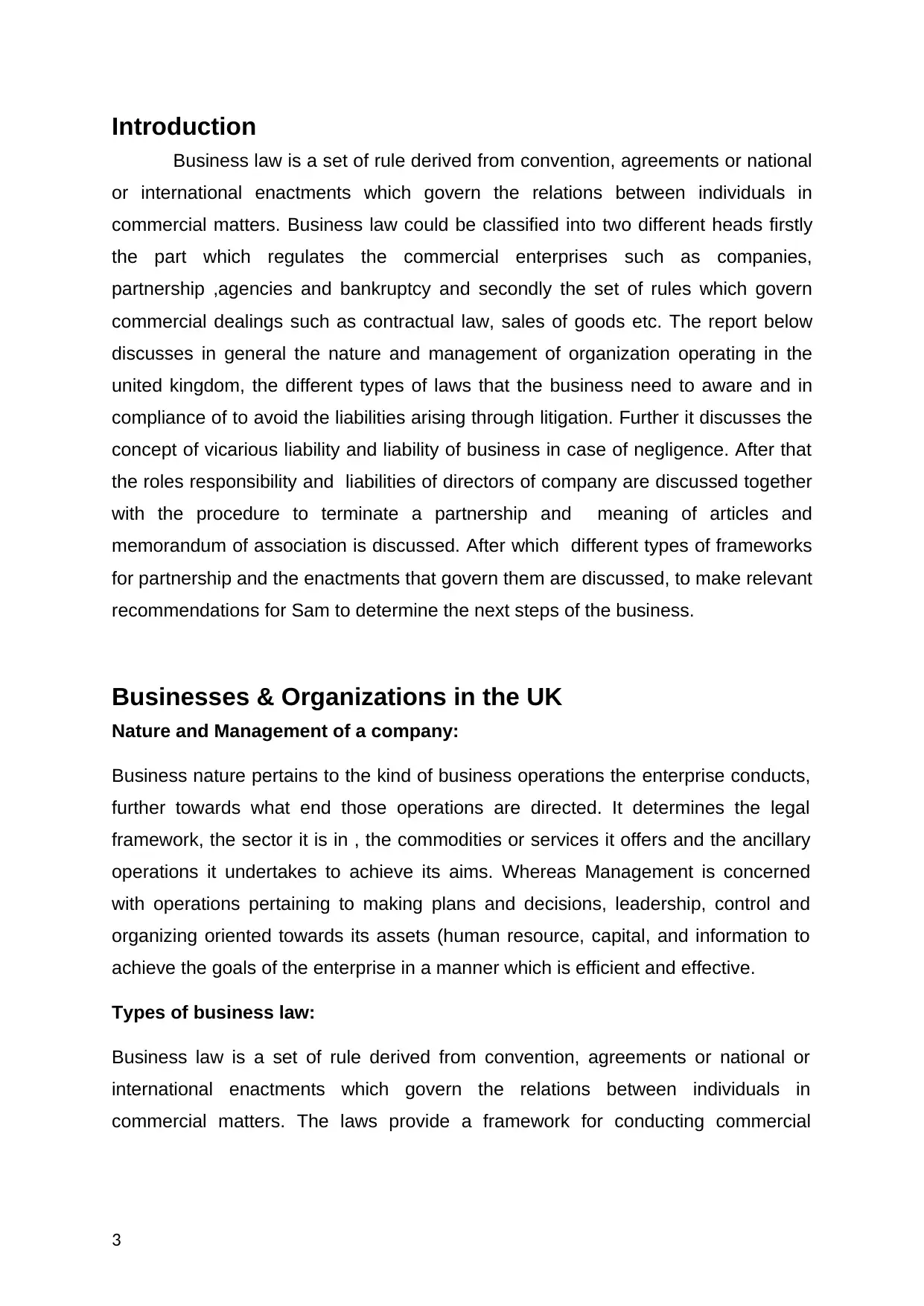
Introduction
Business law is a set of rule derived from convention, agreements or national
or international enactments which govern the relations between individuals in
commercial matters. Business law could be classified into two different heads firstly
the part which regulates the commercial enterprises such as companies,
partnership ,agencies and bankruptcy and secondly the set of rules which govern
commercial dealings such as contractual law, sales of goods etc. The report below
discusses in general the nature and management of organization operating in the
united kingdom, the different types of laws that the business need to aware and in
compliance of to avoid the liabilities arising through litigation. Further it discusses the
concept of vicarious liability and liability of business in case of negligence. After that
the roles responsibility and liabilities of directors of company are discussed together
with the procedure to terminate a partnership and meaning of articles and
memorandum of association is discussed. After which different types of frameworks
for partnership and the enactments that govern them are discussed, to make relevant
recommendations for Sam to determine the next steps of the business.
Businesses & Organizations in the UK
Nature and Management of a company:
Business nature pertains to the kind of business operations the enterprise conducts,
further towards what end those operations are directed. It determines the legal
framework, the sector it is in , the commodities or services it offers and the ancillary
operations it undertakes to achieve its aims. Whereas Management is concerned
with operations pertaining to making plans and decisions, leadership, control and
organizing oriented towards its assets (human resource, capital, and information to
achieve the goals of the enterprise in a manner which is efficient and effective.
Types of business law:
Business law is a set of rule derived from convention, agreements or national or
international enactments which govern the relations between individuals in
commercial matters. The laws provide a framework for conducting commercial
3
Business law is a set of rule derived from convention, agreements or national
or international enactments which govern the relations between individuals in
commercial matters. Business law could be classified into two different heads firstly
the part which regulates the commercial enterprises such as companies,
partnership ,agencies and bankruptcy and secondly the set of rules which govern
commercial dealings such as contractual law, sales of goods etc. The report below
discusses in general the nature and management of organization operating in the
united kingdom, the different types of laws that the business need to aware and in
compliance of to avoid the liabilities arising through litigation. Further it discusses the
concept of vicarious liability and liability of business in case of negligence. After that
the roles responsibility and liabilities of directors of company are discussed together
with the procedure to terminate a partnership and meaning of articles and
memorandum of association is discussed. After which different types of frameworks
for partnership and the enactments that govern them are discussed, to make relevant
recommendations for Sam to determine the next steps of the business.
Businesses & Organizations in the UK
Nature and Management of a company:
Business nature pertains to the kind of business operations the enterprise conducts,
further towards what end those operations are directed. It determines the legal
framework, the sector it is in , the commodities or services it offers and the ancillary
operations it undertakes to achieve its aims. Whereas Management is concerned
with operations pertaining to making plans and decisions, leadership, control and
organizing oriented towards its assets (human resource, capital, and information to
achieve the goals of the enterprise in a manner which is efficient and effective.
Types of business law:
Business law is a set of rule derived from convention, agreements or national or
international enactments which govern the relations between individuals in
commercial matters. The laws provide a framework for conducting commercial
3
⊘ This is a preview!⊘
Do you want full access?
Subscribe today to unlock all pages.

Trusted by 1+ million students worldwide
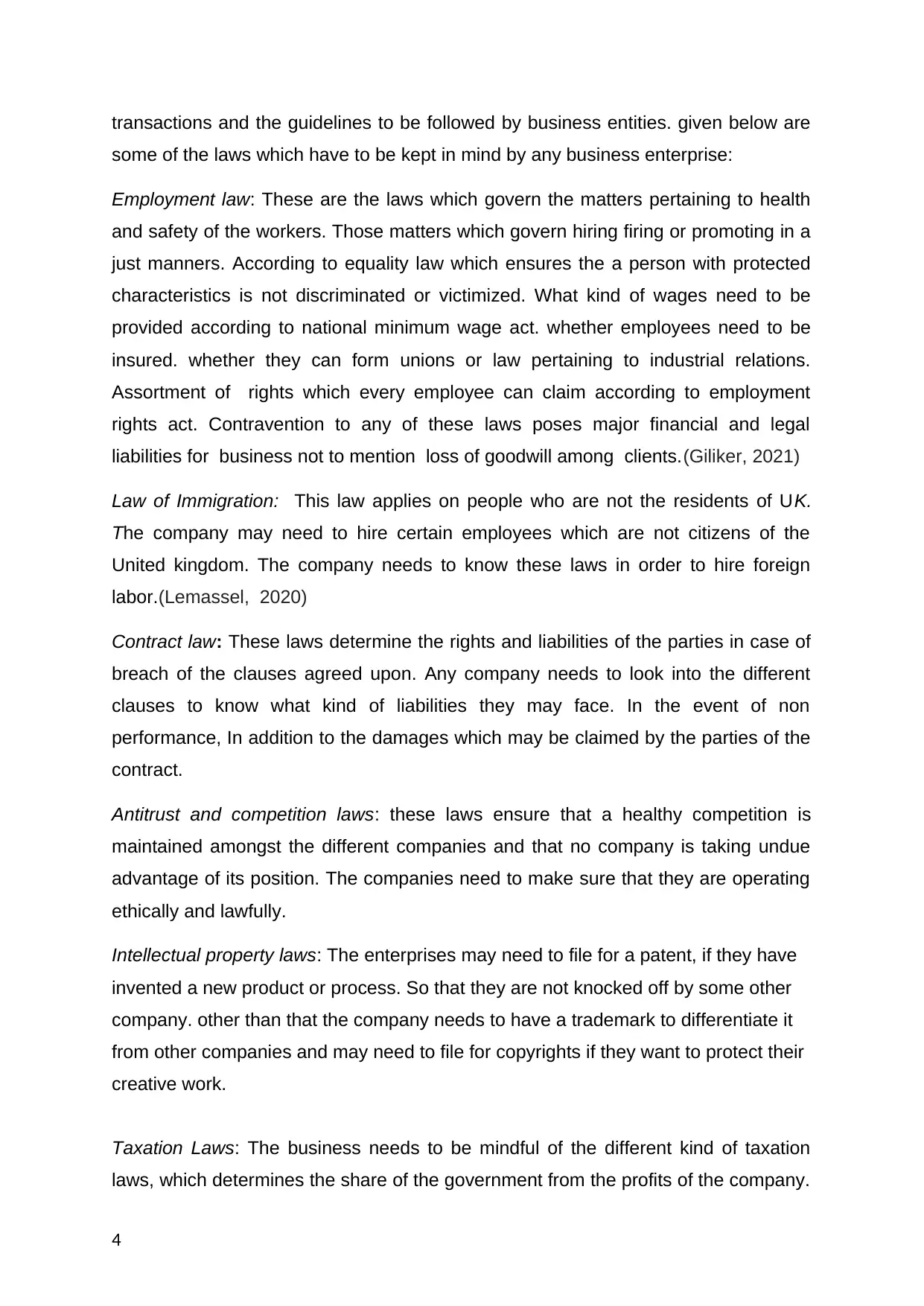
transactions and the guidelines to be followed by business entities. given below are
some of the laws which have to be kept in mind by any business enterprise:
Employment law: These are the laws which govern the matters pertaining to health
and safety of the workers. Those matters which govern hiring firing or promoting in a
just manners. According to equality law which ensures the a person with protected
characteristics is not discriminated or victimized. What kind of wages need to be
provided according to national minimum wage act. whether employees need to be
insured. whether they can form unions or law pertaining to industrial relations.
Assortment of rights which every employee can claim according to employment
rights act. Contravention to any of these laws poses major financial and legal
liabilities for business not to mention loss of goodwill among clients.(Giliker, 2021)
Law of Immigration: This law applies on people who are not the residents of UK.
The company may need to hire certain employees which are not citizens of the
United kingdom. The company needs to know these laws in order to hire foreign
labor.(Lemassel, 2020)
Contract law: These laws determine the rights and liabilities of the parties in case of
breach of the clauses agreed upon. Any company needs to look into the different
clauses to know what kind of liabilities they may face. In the event of non
performance, In addition to the damages which may be claimed by the parties of the
contract.
Antitrust and competition laws: these laws ensure that a healthy competition is
maintained amongst the different companies and that no company is taking undue
advantage of its position. The companies need to make sure that they are operating
ethically and lawfully.
Intellectual property laws: The enterprises may need to file for a patent, if they have
invented a new product or process. So that they are not knocked off by some other
company. other than that the company needs to have a trademark to differentiate it
from other companies and may need to file for copyrights if they want to protect their
creative work.
Taxation Laws: The business needs to be mindful of the different kind of taxation
laws, which determines the share of the government from the profits of the company.
4
some of the laws which have to be kept in mind by any business enterprise:
Employment law: These are the laws which govern the matters pertaining to health
and safety of the workers. Those matters which govern hiring firing or promoting in a
just manners. According to equality law which ensures the a person with protected
characteristics is not discriminated or victimized. What kind of wages need to be
provided according to national minimum wage act. whether employees need to be
insured. whether they can form unions or law pertaining to industrial relations.
Assortment of rights which every employee can claim according to employment
rights act. Contravention to any of these laws poses major financial and legal
liabilities for business not to mention loss of goodwill among clients.(Giliker, 2021)
Law of Immigration: This law applies on people who are not the residents of UK.
The company may need to hire certain employees which are not citizens of the
United kingdom. The company needs to know these laws in order to hire foreign
labor.(Lemassel, 2020)
Contract law: These laws determine the rights and liabilities of the parties in case of
breach of the clauses agreed upon. Any company needs to look into the different
clauses to know what kind of liabilities they may face. In the event of non
performance, In addition to the damages which may be claimed by the parties of the
contract.
Antitrust and competition laws: these laws ensure that a healthy competition is
maintained amongst the different companies and that no company is taking undue
advantage of its position. The companies need to make sure that they are operating
ethically and lawfully.
Intellectual property laws: The enterprises may need to file for a patent, if they have
invented a new product or process. So that they are not knocked off by some other
company. other than that the company needs to have a trademark to differentiate it
from other companies and may need to file for copyrights if they want to protect their
creative work.
Taxation Laws: The business needs to be mindful of the different kind of taxation
laws, which determines the share of the government from the profits of the company.
4
Paraphrase This Document
Need a fresh take? Get an instant paraphrase of this document with our AI Paraphraser
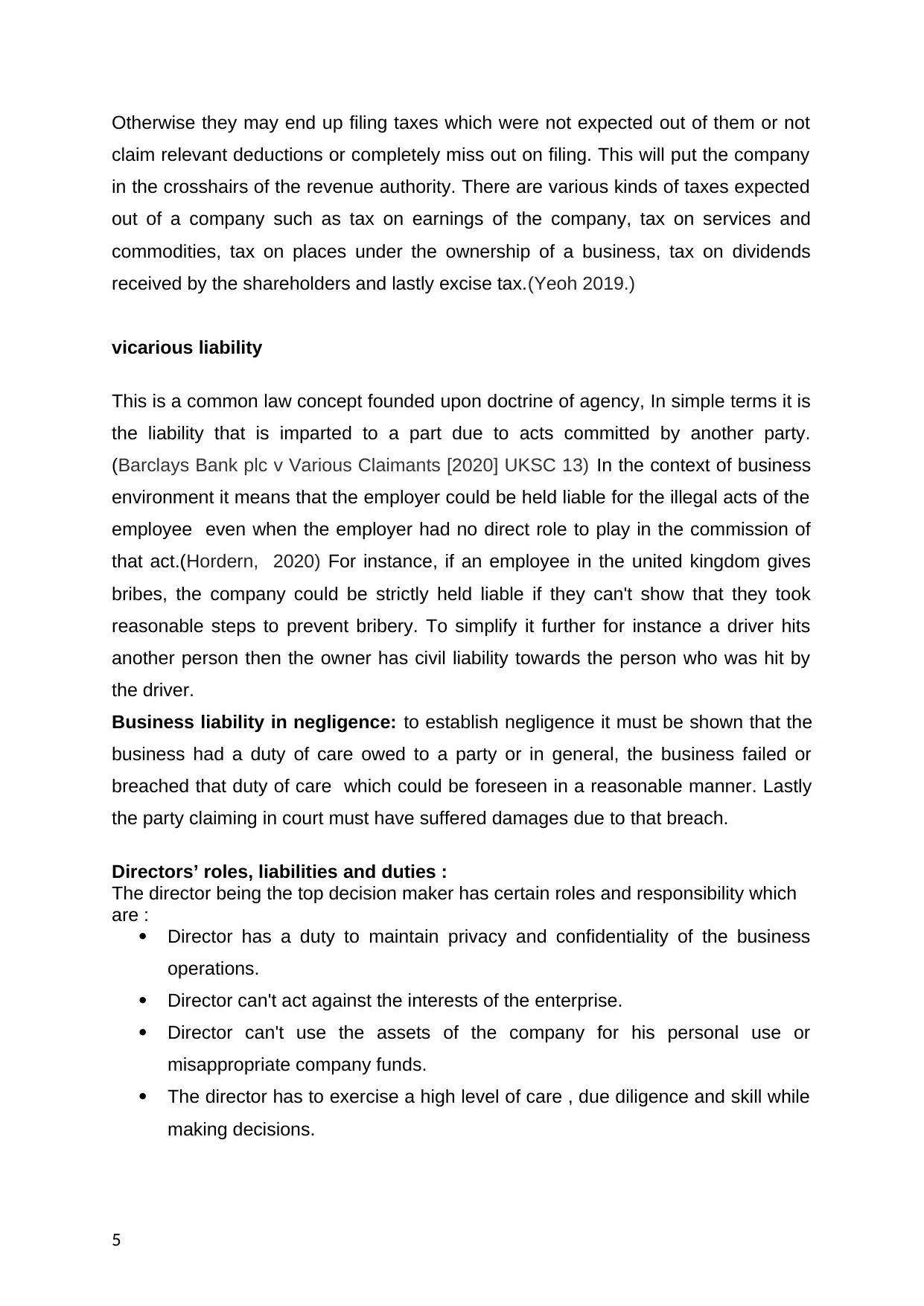
Otherwise they may end up filing taxes which were not expected out of them or not
claim relevant deductions or completely miss out on filing. This will put the company
in the crosshairs of the revenue authority. There are various kinds of taxes expected
out of a company such as tax on earnings of the company, tax on services and
commodities, tax on places under the ownership of a business, tax on dividends
received by the shareholders and lastly excise tax.(Yeoh 2019.)
vicarious liability
This is a common law concept founded upon doctrine of agency, In simple terms it is
the liability that is imparted to a part due to acts committed by another party.
(Barclays Bank plc v Various Claimants [2020] UKSC 13) In the context of business
environment it means that the employer could be held liable for the illegal acts of the
employee even when the employer had no direct role to play in the commission of
that act.(Hordern, 2020) For instance, if an employee in the united kingdom gives
bribes, the company could be strictly held liable if they can't show that they took
reasonable steps to prevent bribery. To simplify it further for instance a driver hits
another person then the owner has civil liability towards the person who was hit by
the driver.
Business liability in negligence: to establish negligence it must be shown that the
business had a duty of care owed to a party or in general, the business failed or
breached that duty of care which could be foreseen in a reasonable manner. Lastly
the party claiming in court must have suffered damages due to that breach.
Directors’ roles, liabilities and duties :
The director being the top decision maker has certain roles and responsibility which
are :
Director has a duty to maintain privacy and confidentiality of the business
operations.
Director can't act against the interests of the enterprise.
Director can't use the assets of the company for his personal use or
misappropriate company funds.
The director has to exercise a high level of care , due diligence and skill while
making decisions.
5
claim relevant deductions or completely miss out on filing. This will put the company
in the crosshairs of the revenue authority. There are various kinds of taxes expected
out of a company such as tax on earnings of the company, tax on services and
commodities, tax on places under the ownership of a business, tax on dividends
received by the shareholders and lastly excise tax.(Yeoh 2019.)
vicarious liability
This is a common law concept founded upon doctrine of agency, In simple terms it is
the liability that is imparted to a part due to acts committed by another party.
(Barclays Bank plc v Various Claimants [2020] UKSC 13) In the context of business
environment it means that the employer could be held liable for the illegal acts of the
employee even when the employer had no direct role to play in the commission of
that act.(Hordern, 2020) For instance, if an employee in the united kingdom gives
bribes, the company could be strictly held liable if they can't show that they took
reasonable steps to prevent bribery. To simplify it further for instance a driver hits
another person then the owner has civil liability towards the person who was hit by
the driver.
Business liability in negligence: to establish negligence it must be shown that the
business had a duty of care owed to a party or in general, the business failed or
breached that duty of care which could be foreseen in a reasonable manner. Lastly
the party claiming in court must have suffered damages due to that breach.
Directors’ roles, liabilities and duties :
The director being the top decision maker has certain roles and responsibility which
are :
Director has a duty to maintain privacy and confidentiality of the business
operations.
Director can't act against the interests of the enterprise.
Director can't use the assets of the company for his personal use or
misappropriate company funds.
The director has to exercise a high level of care , due diligence and skill while
making decisions.
5
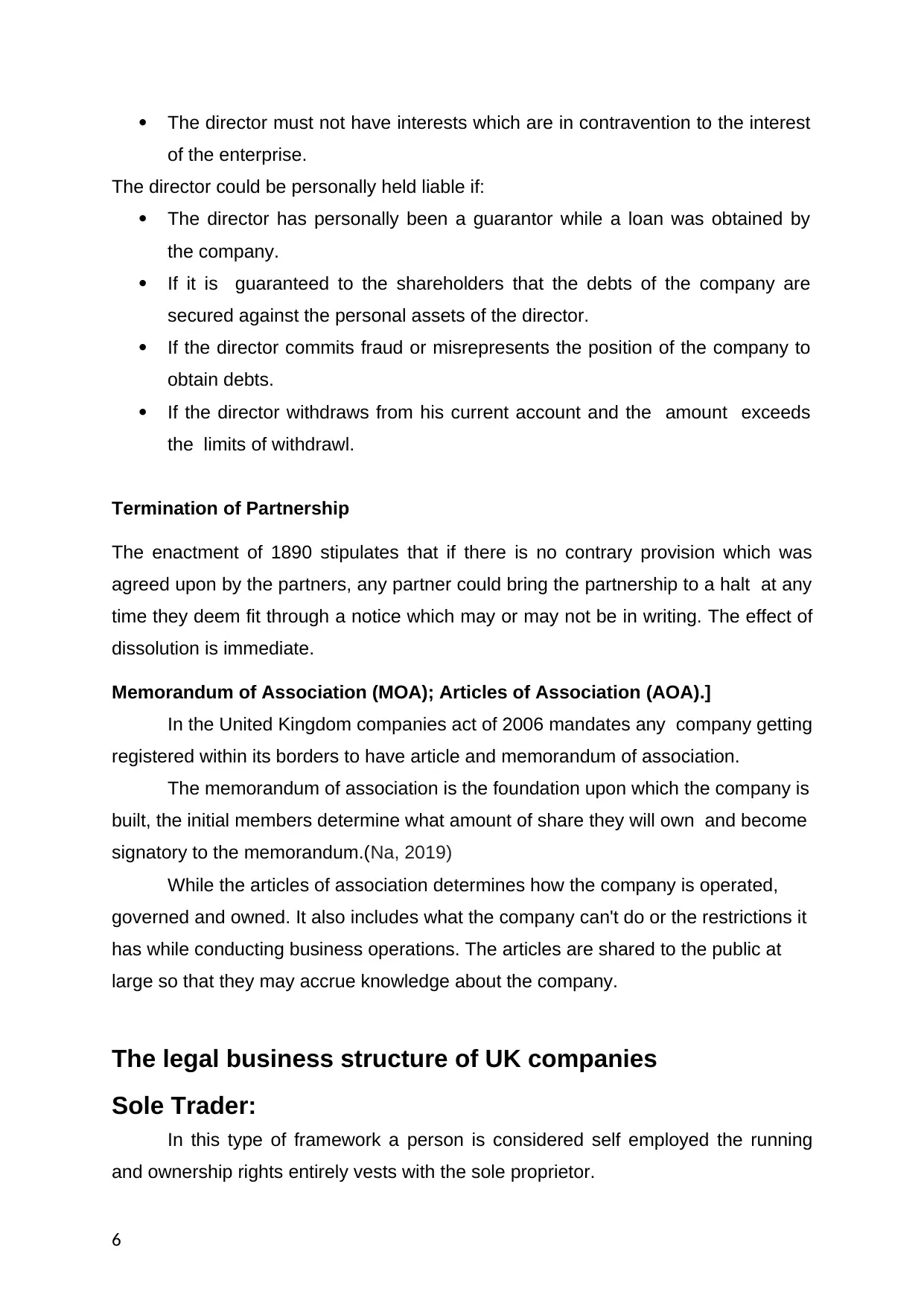
The director must not have interests which are in contravention to the interest
of the enterprise.
The director could be personally held liable if:
The director has personally been a guarantor while a loan was obtained by
the company.
If it is guaranteed to the shareholders that the debts of the company are
secured against the personal assets of the director.
If the director commits fraud or misrepresents the position of the company to
obtain debts.
If the director withdraws from his current account and the amount exceeds
the limits of withdrawl.
Termination of Partnership
The enactment of 1890 stipulates that if there is no contrary provision which was
agreed upon by the partners, any partner could bring the partnership to a halt at any
time they deem fit through a notice which may or may not be in writing. The effect of
dissolution is immediate.
Memorandum of Association (MOA); Articles of Association (AOA).]
In the United Kingdom companies act of 2006 mandates any company getting
registered within its borders to have article and memorandum of association.
The memorandum of association is the foundation upon which the company is
built, the initial members determine what amount of share they will own and become
signatory to the memorandum.(Na, 2019)
While the articles of association determines how the company is operated,
governed and owned. It also includes what the company can't do or the restrictions it
has while conducting business operations. The articles are shared to the public at
large so that they may accrue knowledge about the company.
The legal business structure of UK companies
Sole Trader:
In this type of framework a person is considered self employed the running
and ownership rights entirely vests with the sole proprietor.
6
of the enterprise.
The director could be personally held liable if:
The director has personally been a guarantor while a loan was obtained by
the company.
If it is guaranteed to the shareholders that the debts of the company are
secured against the personal assets of the director.
If the director commits fraud or misrepresents the position of the company to
obtain debts.
If the director withdraws from his current account and the amount exceeds
the limits of withdrawl.
Termination of Partnership
The enactment of 1890 stipulates that if there is no contrary provision which was
agreed upon by the partners, any partner could bring the partnership to a halt at any
time they deem fit through a notice which may or may not be in writing. The effect of
dissolution is immediate.
Memorandum of Association (MOA); Articles of Association (AOA).]
In the United Kingdom companies act of 2006 mandates any company getting
registered within its borders to have article and memorandum of association.
The memorandum of association is the foundation upon which the company is
built, the initial members determine what amount of share they will own and become
signatory to the memorandum.(Na, 2019)
While the articles of association determines how the company is operated,
governed and owned. It also includes what the company can't do or the restrictions it
has while conducting business operations. The articles are shared to the public at
large so that they may accrue knowledge about the company.
The legal business structure of UK companies
Sole Trader:
In this type of framework a person is considered self employed the running
and ownership rights entirely vests with the sole proprietor.
6
⊘ This is a preview!⊘
Do you want full access?
Subscribe today to unlock all pages.

Trusted by 1+ million students worldwide
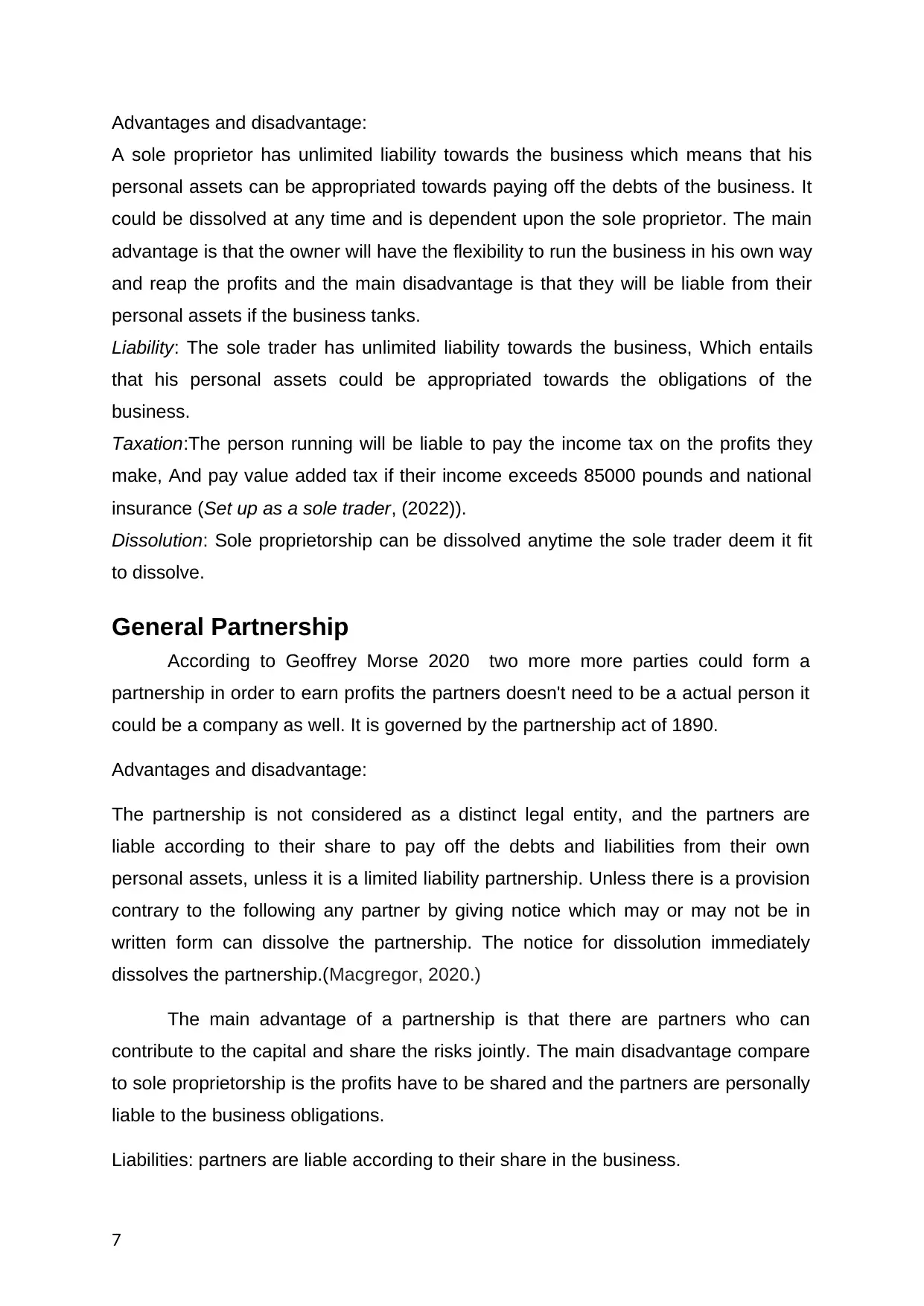
Advantages and disadvantage:
A sole proprietor has unlimited liability towards the business which means that his
personal assets can be appropriated towards paying off the debts of the business. It
could be dissolved at any time and is dependent upon the sole proprietor. The main
advantage is that the owner will have the flexibility to run the business in his own way
and reap the profits and the main disadvantage is that they will be liable from their
personal assets if the business tanks.
Liability: The sole trader has unlimited liability towards the business, Which entails
that his personal assets could be appropriated towards the obligations of the
business.
Taxation:The person running will be liable to pay the income tax on the profits they
make, And pay value added tax if their income exceeds 85000 pounds and national
insurance (Set up as a sole trader, (2022)).
Dissolution: Sole proprietorship can be dissolved anytime the sole trader deem it fit
to dissolve.
General Partnership
According to Geoffrey Morse 2020 two more more parties could form a
partnership in order to earn profits the partners doesn't need to be a actual person it
could be a company as well. It is governed by the partnership act of 1890.
Advantages and disadvantage:
The partnership is not considered as a distinct legal entity, and the partners are
liable according to their share to pay off the debts and liabilities from their own
personal assets, unless it is a limited liability partnership. Unless there is a provision
contrary to the following any partner by giving notice which may or may not be in
written form can dissolve the partnership. The notice for dissolution immediately
dissolves the partnership.(Macgregor, 2020.)
The main advantage of a partnership is that there are partners who can
contribute to the capital and share the risks jointly. The main disadvantage compare
to sole proprietorship is the profits have to be shared and the partners are personally
liable to the business obligations.
Liabilities: partners are liable according to their share in the business.
7
A sole proprietor has unlimited liability towards the business which means that his
personal assets can be appropriated towards paying off the debts of the business. It
could be dissolved at any time and is dependent upon the sole proprietor. The main
advantage is that the owner will have the flexibility to run the business in his own way
and reap the profits and the main disadvantage is that they will be liable from their
personal assets if the business tanks.
Liability: The sole trader has unlimited liability towards the business, Which entails
that his personal assets could be appropriated towards the obligations of the
business.
Taxation:The person running will be liable to pay the income tax on the profits they
make, And pay value added tax if their income exceeds 85000 pounds and national
insurance (Set up as a sole trader, (2022)).
Dissolution: Sole proprietorship can be dissolved anytime the sole trader deem it fit
to dissolve.
General Partnership
According to Geoffrey Morse 2020 two more more parties could form a
partnership in order to earn profits the partners doesn't need to be a actual person it
could be a company as well. It is governed by the partnership act of 1890.
Advantages and disadvantage:
The partnership is not considered as a distinct legal entity, and the partners are
liable according to their share to pay off the debts and liabilities from their own
personal assets, unless it is a limited liability partnership. Unless there is a provision
contrary to the following any partner by giving notice which may or may not be in
written form can dissolve the partnership. The notice for dissolution immediately
dissolves the partnership.(Macgregor, 2020.)
The main advantage of a partnership is that there are partners who can
contribute to the capital and share the risks jointly. The main disadvantage compare
to sole proprietorship is the profits have to be shared and the partners are personally
liable to the business obligations.
Liabilities: partners are liable according to their share in the business.
7
Paraphrase This Document
Need a fresh take? Get an instant paraphrase of this document with our AI Paraphraser
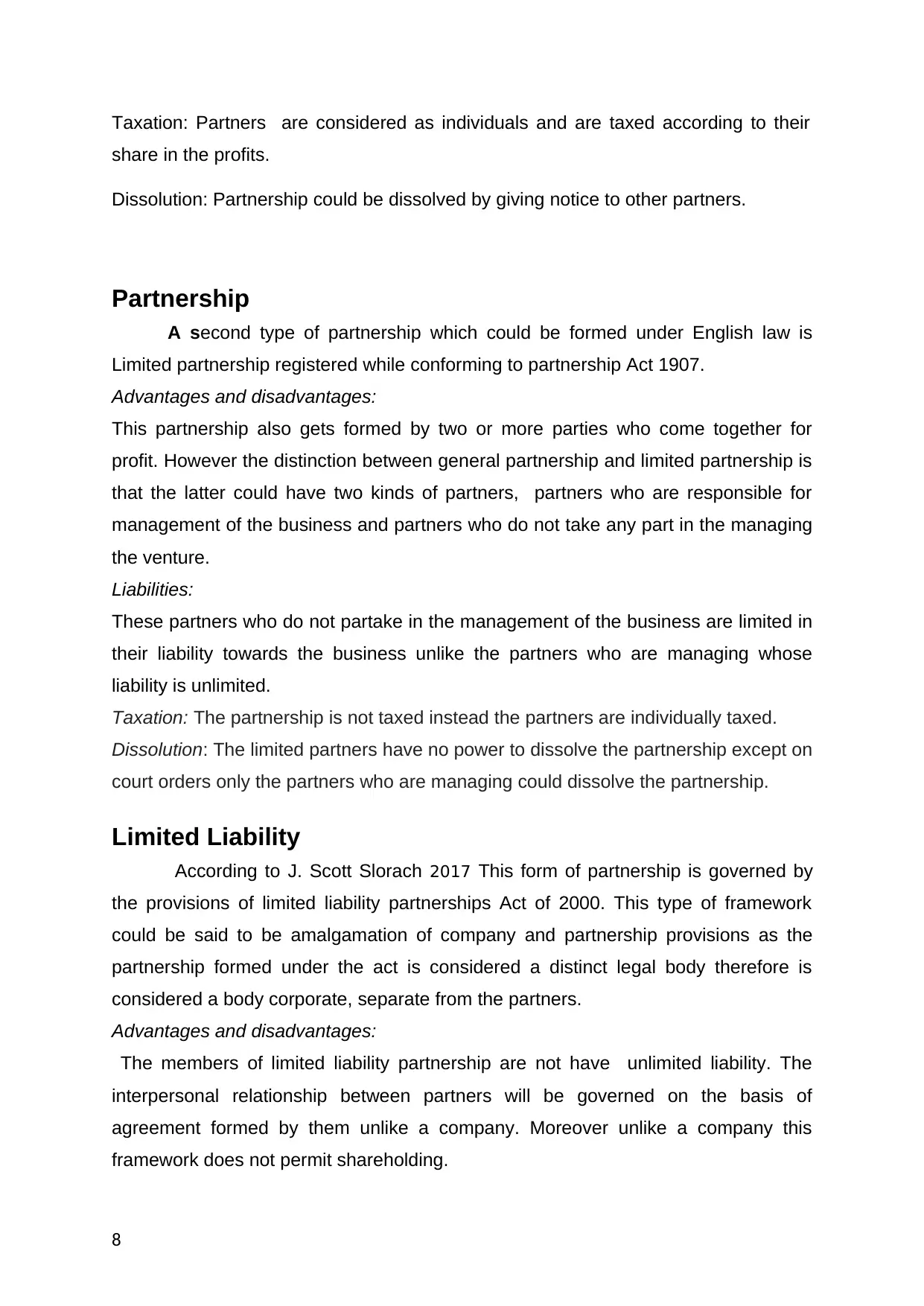
Taxation: Partners are considered as individuals and are taxed according to their
share in the profits.
Dissolution: Partnership could be dissolved by giving notice to other partners.
Partnership
A second type of partnership which could be formed under English law is
Limited partnership registered while conforming to partnership Act 1907.
Advantages and disadvantages:
This partnership also gets formed by two or more parties who come together for
profit. However the distinction between general partnership and limited partnership is
that the latter could have two kinds of partners, partners who are responsible for
management of the business and partners who do not take any part in the managing
the venture.
Liabilities:
These partners who do not partake in the management of the business are limited in
their liability towards the business unlike the partners who are managing whose
liability is unlimited.
Taxation: The partnership is not taxed instead the partners are individually taxed.
Dissolution: The limited partners have no power to dissolve the partnership except on
court orders only the partners who are managing could dissolve the partnership.
Limited Liability
According to J. Scott Slorach 2017 This form of partnership is governed by
the provisions of limited liability partnerships Act of 2000. This type of framework
could be said to be amalgamation of company and partnership provisions as the
partnership formed under the act is considered a distinct legal body therefore is
considered a body corporate, separate from the partners.
Advantages and disadvantages:
The members of limited liability partnership are not have unlimited liability. The
interpersonal relationship between partners will be governed on the basis of
agreement formed by them unlike a company. Moreover unlike a company this
framework does not permit shareholding.
8
share in the profits.
Dissolution: Partnership could be dissolved by giving notice to other partners.
Partnership
A second type of partnership which could be formed under English law is
Limited partnership registered while conforming to partnership Act 1907.
Advantages and disadvantages:
This partnership also gets formed by two or more parties who come together for
profit. However the distinction between general partnership and limited partnership is
that the latter could have two kinds of partners, partners who are responsible for
management of the business and partners who do not take any part in the managing
the venture.
Liabilities:
These partners who do not partake in the management of the business are limited in
their liability towards the business unlike the partners who are managing whose
liability is unlimited.
Taxation: The partnership is not taxed instead the partners are individually taxed.
Dissolution: The limited partners have no power to dissolve the partnership except on
court orders only the partners who are managing could dissolve the partnership.
Limited Liability
According to J. Scott Slorach 2017 This form of partnership is governed by
the provisions of limited liability partnerships Act of 2000. This type of framework
could be said to be amalgamation of company and partnership provisions as the
partnership formed under the act is considered a distinct legal body therefore is
considered a body corporate, separate from the partners.
Advantages and disadvantages:
The members of limited liability partnership are not have unlimited liability. The
interpersonal relationship between partners will be governed on the basis of
agreement formed by them unlike a company. Moreover unlike a company this
framework does not permit shareholding.
8
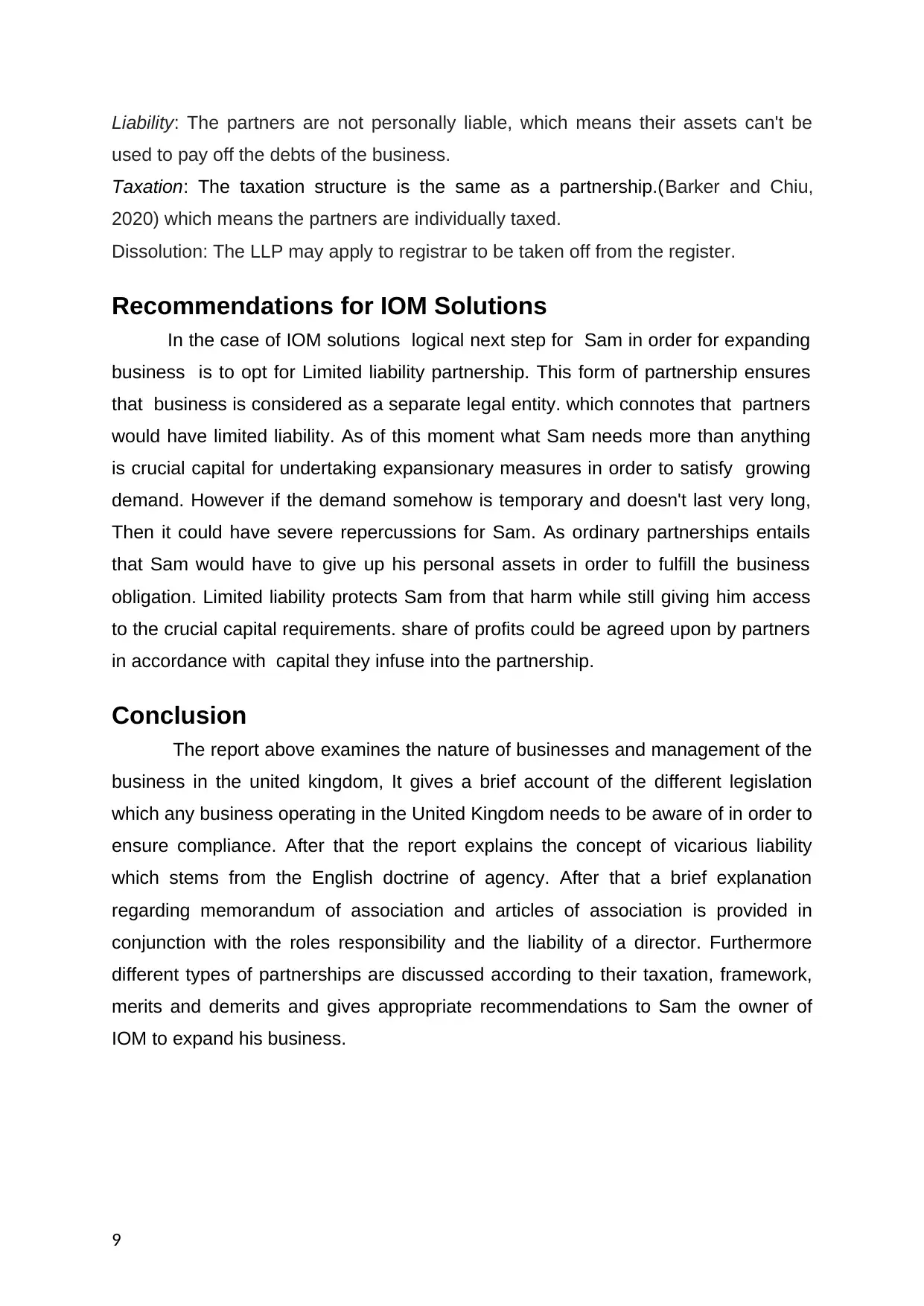
Liability: The partners are not personally liable, which means their assets can't be
used to pay off the debts of the business.
Taxation: The taxation structure is the same as a partnership.(Barker and Chiu,
2020) which means the partners are individually taxed.
Dissolution: The LLP may apply to registrar to be taken off from the register.
Recommendations for IOM Solutions
In the case of IOM solutions logical next step for Sam in order for expanding
business is to opt for Limited liability partnership. This form of partnership ensures
that business is considered as a separate legal entity. which connotes that partners
would have limited liability. As of this moment what Sam needs more than anything
is crucial capital for undertaking expansionary measures in order to satisfy growing
demand. However if the demand somehow is temporary and doesn't last very long,
Then it could have severe repercussions for Sam. As ordinary partnerships entails
that Sam would have to give up his personal assets in order to fulfill the business
obligation. Limited liability protects Sam from that harm while still giving him access
to the crucial capital requirements. share of profits could be agreed upon by partners
in accordance with capital they infuse into the partnership.
Conclusion
The report above examines the nature of businesses and management of the
business in the united kingdom, It gives a brief account of the different legislation
which any business operating in the United Kingdom needs to be aware of in order to
ensure compliance. After that the report explains the concept of vicarious liability
which stems from the English doctrine of agency. After that a brief explanation
regarding memorandum of association and articles of association is provided in
conjunction with the roles responsibility and the liability of a director. Furthermore
different types of partnerships are discussed according to their taxation, framework,
merits and demerits and gives appropriate recommendations to Sam the owner of
IOM to expand his business.
9
used to pay off the debts of the business.
Taxation: The taxation structure is the same as a partnership.(Barker and Chiu,
2020) which means the partners are individually taxed.
Dissolution: The LLP may apply to registrar to be taken off from the register.
Recommendations for IOM Solutions
In the case of IOM solutions logical next step for Sam in order for expanding
business is to opt for Limited liability partnership. This form of partnership ensures
that business is considered as a separate legal entity. which connotes that partners
would have limited liability. As of this moment what Sam needs more than anything
is crucial capital for undertaking expansionary measures in order to satisfy growing
demand. However if the demand somehow is temporary and doesn't last very long,
Then it could have severe repercussions for Sam. As ordinary partnerships entails
that Sam would have to give up his personal assets in order to fulfill the business
obligation. Limited liability protects Sam from that harm while still giving him access
to the crucial capital requirements. share of profits could be agreed upon by partners
in accordance with capital they infuse into the partnership.
Conclusion
The report above examines the nature of businesses and management of the
business in the united kingdom, It gives a brief account of the different legislation
which any business operating in the United Kingdom needs to be aware of in order to
ensure compliance. After that the report explains the concept of vicarious liability
which stems from the English doctrine of agency. After that a brief explanation
regarding memorandum of association and articles of association is provided in
conjunction with the roles responsibility and the liability of a director. Furthermore
different types of partnerships are discussed according to their taxation, framework,
merits and demerits and gives appropriate recommendations to Sam the owner of
IOM to expand his business.
9
⊘ This is a preview!⊘
Do you want full access?
Subscribe today to unlock all pages.

Trusted by 1+ million students worldwide
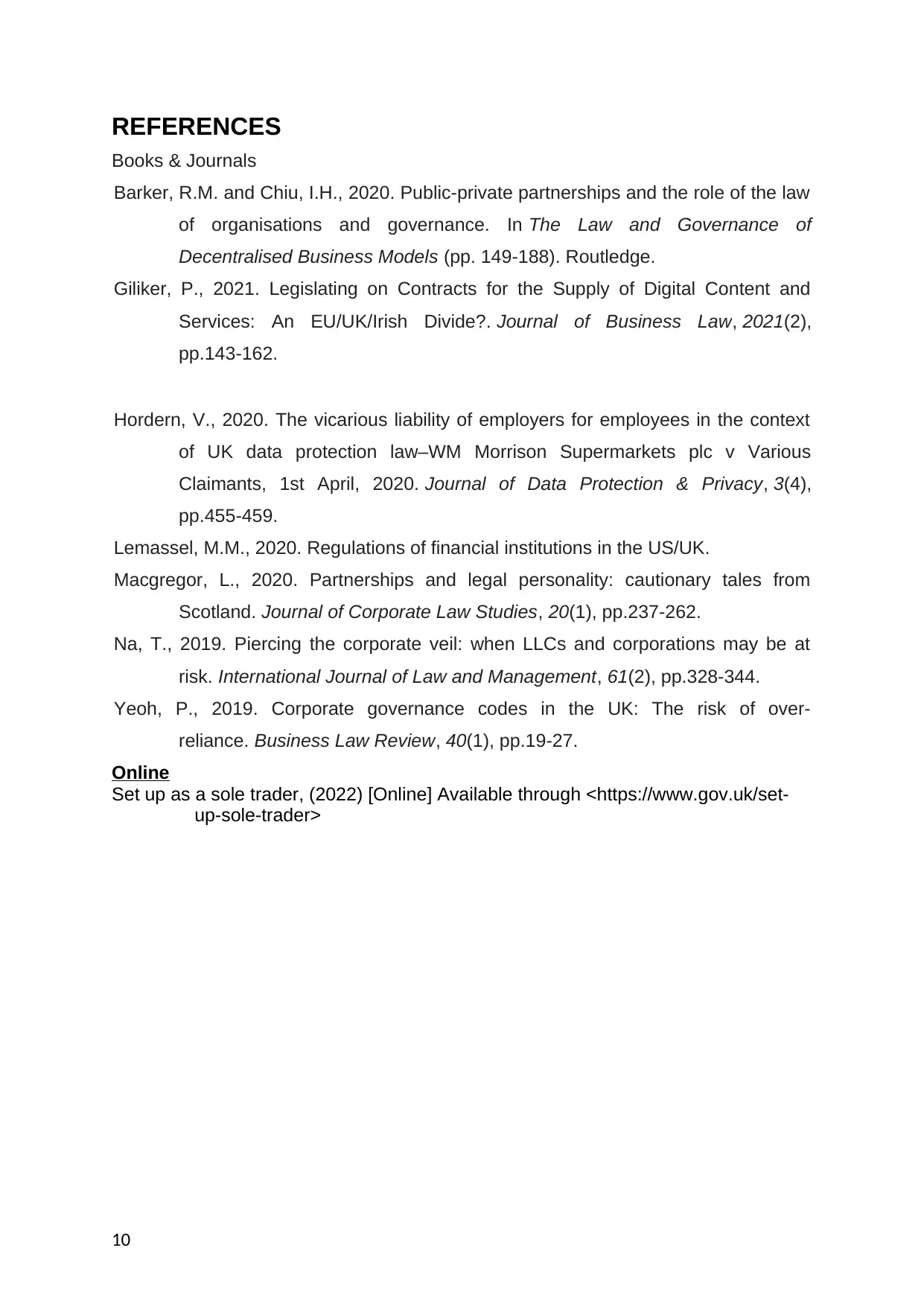
REFERENCES
Books & Journals
Barker, R.M. and Chiu, I.H., 2020. Public-private partnerships and the role of the law
of organisations and governance. In The Law and Governance of
Decentralised Business Models (pp. 149-188). Routledge.
Giliker, P., 2021. Legislating on Contracts for the Supply of Digital Content and
Services: An EU/UK/Irish Divide?. Journal of Business Law, 2021(2),
pp.143-162.
Hordern, V., 2020. The vicarious liability of employers for employees in the context
of UK data protection law–WM Morrison Supermarkets plc v Various
Claimants, 1st April, 2020. Journal of Data Protection & Privacy, 3(4),
pp.455-459.
Lemassel, M.M., 2020. Regulations of financial institutions in the US/UK.
Macgregor, L., 2020. Partnerships and legal personality: cautionary tales from
Scotland. Journal of Corporate Law Studies, 20(1), pp.237-262.
Na, T., 2019. Piercing the corporate veil: when LLCs and corporations may be at
risk. International Journal of Law and Management, 61(2), pp.328-344.
Yeoh, P., 2019. Corporate governance codes in the UK: The risk of over-
reliance. Business Law Review, 40(1), pp.19-27.
Online
Set up as a sole trader, (2022) [Online] Available through <https://www.gov.uk/set-
up-sole-trader>
10
Books & Journals
Barker, R.M. and Chiu, I.H., 2020. Public-private partnerships and the role of the law
of organisations and governance. In The Law and Governance of
Decentralised Business Models (pp. 149-188). Routledge.
Giliker, P., 2021. Legislating on Contracts for the Supply of Digital Content and
Services: An EU/UK/Irish Divide?. Journal of Business Law, 2021(2),
pp.143-162.
Hordern, V., 2020. The vicarious liability of employers for employees in the context
of UK data protection law–WM Morrison Supermarkets plc v Various
Claimants, 1st April, 2020. Journal of Data Protection & Privacy, 3(4),
pp.455-459.
Lemassel, M.M., 2020. Regulations of financial institutions in the US/UK.
Macgregor, L., 2020. Partnerships and legal personality: cautionary tales from
Scotland. Journal of Corporate Law Studies, 20(1), pp.237-262.
Na, T., 2019. Piercing the corporate veil: when LLCs and corporations may be at
risk. International Journal of Law and Management, 61(2), pp.328-344.
Yeoh, P., 2019. Corporate governance codes in the UK: The risk of over-
reliance. Business Law Review, 40(1), pp.19-27.
Online
Set up as a sole trader, (2022) [Online] Available through <https://www.gov.uk/set-
up-sole-trader>
10
1 out of 10
Related Documents
Your All-in-One AI-Powered Toolkit for Academic Success.
+13062052269
info@desklib.com
Available 24*7 on WhatsApp / Email
![[object Object]](/_next/static/media/star-bottom.7253800d.svg)
Unlock your academic potential
Copyright © 2020–2025 A2Z Services. All Rights Reserved. Developed and managed by ZUCOL.



